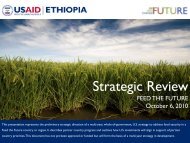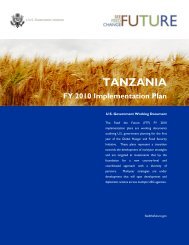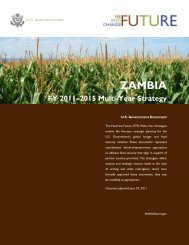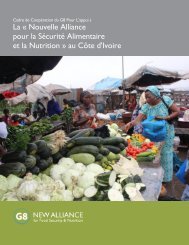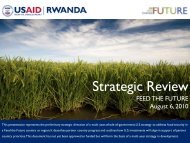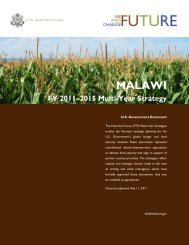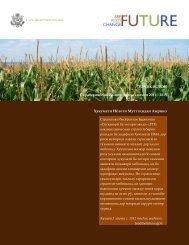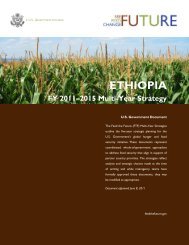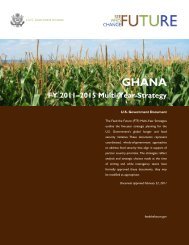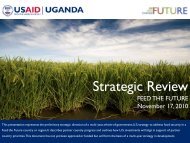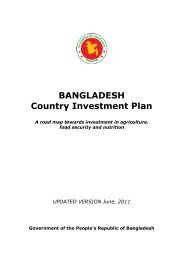Feed the Future Multi-Year Strategy, Senegal, Public
Feed the Future Multi-Year Strategy, Senegal, Public
Feed the Future Multi-Year Strategy, Senegal, Public
Create successful ePaper yourself
Turn your PDF publications into a flip-book with our unique Google optimized e-Paper software.
months are not fed according to recommended complementary feeding practices. Second, in <strong>the</strong> arena<br />
of hygiene practices, although 98 percent of <strong>Senegal</strong>ese have relatively high access to potable water and<br />
77 percent have access to sanitation facilities, more than one-fifth or 22 percent of all <strong>Senegal</strong>ese<br />
children suffer from diarrhea. Third, 58 percent of <strong>the</strong> <strong>Senegal</strong>ese diet consists mainly of cereals such as<br />
millet, sorghum, and particularly rice, which does not provide dietary diversity. Vegetables and protein<br />
sources are low in <strong>Senegal</strong>. Fish, <strong>the</strong> main protein source, accounts for 47 percent, of protein<br />
consumed. Although this household food basket is complemented by groundnuts and cowpeas, cereals<br />
represent approximately two-thirds of <strong>the</strong> dietary energy supply. Fourth, populations are also subject to<br />
a “hungry season” between <strong>the</strong> time that <strong>the</strong> last of <strong>the</strong> previous year’s food stocks run out and <strong>the</strong><br />
harvest of <strong>the</strong> following year. Compounding this, <strong>the</strong>re is often a corresponding lack of income during<br />
this period right before <strong>the</strong> new crops go to <strong>the</strong> market. The availability of a balanced diet is<br />
compromised as <strong>the</strong> variety and quantity of food is limited, for example, more expensive items like meat<br />
are eliminated and <strong>the</strong> number of meals is reduced.<br />
These challenges require a strong emphasis on improving nutrition, hygiene, and health seeking<br />
behaviors as well as improving access to and quality of health care and nutrition services. Promotion of<br />
a more diverse food basket at <strong>the</strong> community level ra<strong>the</strong>r than <strong>the</strong> clinical level will also address <strong>the</strong><br />
aforementioned challenges. The strategy will seek to implement a holistic, yet targeted approach;<br />
including complementary activities in nutrition and agriculture that boost <strong>the</strong> larger investments in value<br />
chains.<br />
2.2 OPPORTUNITIES<br />
The U.S. Government leverages expertise in valuable areas vis-à-vis o<strong>the</strong>r donors and institutions<br />
including application of <strong>the</strong> value chain approach. This is a method for which <strong>the</strong> USG holds a<br />
comparative advantage among development partners. For <strong>the</strong> purposes of FTF, three staple grain value<br />
chains (rice, maize, and millet) were selected for <strong>the</strong>ir associated high growth potential, scalability, and<br />
potential to leverage o<strong>the</strong>r USG, GOS, and development partner investments. In addition, USAID will<br />
work in <strong>Senegal</strong>’s sizable fisheries sector, a source of high economic and nutritional contribution, yet a<br />
diminishing resource. Clearly, o<strong>the</strong>r GOS-prioritized sectors are important to <strong>the</strong> overall agricultural<br />
economy, however <strong>the</strong>se <strong>Senegal</strong>ese staples greatly influence daily diets in <strong>the</strong> poorest regions, hold <strong>the</strong><br />
greatest potential for reducing undernutrition and poverty, and offer geographic focus to increase <strong>the</strong><br />
impact of <strong>the</strong> USG’s overall development investments in two agro-ecological zones: <strong>the</strong> <strong>Senegal</strong> River<br />
Valley (SRV) and <strong>the</strong> Sou<strong>the</strong>rn Forest Zone (SFZ). In <strong>the</strong> SRV and <strong>the</strong> SFZ, combined USG and donor<br />
investments will create corridors of agricultural productivity and improve <strong>the</strong> private sector business<br />
environment, facilitating “agricultural growth corridors.” These two focus zones touch on parts of nine<br />
administrative regions representing 42.6 percent of <strong>Senegal</strong>’s population and include <strong>the</strong> five poorest<br />
regions: Fatick, Kedougou, Kolda, Matam, and Tambacounda. However, since value chain development is<br />
used to satisfy urban market demand, <strong>the</strong> FTF impact will be broader than <strong>the</strong>se targeted areas and<br />
beneficiaries. In fact, <strong>the</strong> coastal and western regions (Dakar, Kaolack, Touba, Thies, and Saint-Louis) are<br />
<strong>the</strong> most important markets for cereals.<br />
USAID will build on past investments in natural resources management to ensure increases in<br />
productivity and greater resilience to climatic variability in <strong>the</strong> agricultural growth corridors in SRV and<br />
SFZ. Augmenting this geographic focus are <strong>the</strong> Essential Nutrition Actions (ENA) program which will be<br />
promoted nationwide through <strong>Senegal</strong>’s health hut network, seed lab development, and <strong>the</strong> related<br />
capacity building associated with each.<br />
7



